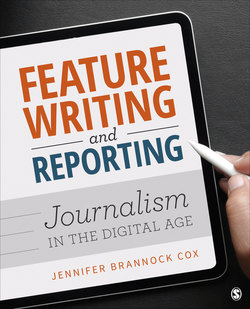Читать книгу Feature Writing and Reporting - Jennifer Brannock Cox - Страница 54
На сайте Литреса книга снята с продажи.
From the Field Building Descriptive Narration
ОглавлениеAdjectives should be used sparingly in journalistic writing, so it is important to choose the right ones. Selecting the right words to describe a character depends on keen observational skills. Show, don’t tell.
Figure 2.5 Telling
In telling rather than showing, you are making an opinionated statement: “Colson works hard.” Instead of inserting your own assessment of the dancer’s work ethic, show the reader with a narration based on observed details, as illustrated in Figure 2.5. Think about the character as if you are building steps up to a landing. Starting with the most basic details, which are still essential to the story, imagine how you can add to a general description to create an illustration for your audience, like Figure 2.6.
Figure 2.6 Showing
Narrative writing shares some similarities with human interest profiles in that careful character development is key. Unlike profiles, which are primarily focused on the story of a particular person or group, narratives use sources to illustrate a larger issue at play. They often rely heavily on dialogue and flashbacks from main characters to help explain how an issue came to be. Washington Monthly magazine reporter Mariah Blake used narration to talk about problems with America’s health care system.7 She used a primary character—medical device maker Thomas Shaw—to illustrate the larger problems facing the industry. Blake sets the scene in this excerpt, showing us Shaw’s frustration by using vivid imagery and dialogue:
When Thomas Shaw gets worked up, he twists in his chair and kneads his hand. Or he paces about in his tube socks grumbling, “They’re trying to destroy us,” and “The whole thing is a giant scam.” And Shaw, the founder of a medical device maker called Retractable Technologies, spends a lot of time being agitated.
Blake also uses physical descriptions of the character, as well as his own recollections of his beginning, to get the reader more invested in the story and visualizing the scene:
Thomas Shaw is a lanky fifty-nine-year-old man with dark eyes and a shock of gray hair that gives him a bit of a mad scientist air. Growing up, he lived in Mexico and Arizona, where his father worked as a chemist (among other things, the elder Shaw invented the first nitrogen test for plants). Shaw describes his childhood home as a kind of frenetic laboratory where science and math problems were worked out on a chalkboard that hung over the dinner table.
Relatable similes and anecdotes can also help readers to visualize the scene and better understand complicated issues like those in Blake’s article:
… Shaw finally came up with a crude prototype and found a local physician to test it on him—an event Shaw’s wife documented with a shaky handheld camcorder. In the video, the doctor holds up a saline-filled syringe about the size of a kielbasa sausage. Then he jabs the needle into Shaw’s arm and pauses for a second before pushing in the plunger. First the saline empties, and then the needle snaps back into the barrel with a pop.
Shaw had just invented the first retractable syringe, a fact that drew the attention of public health officials.
Throughout the story, the author hearkens back to the central point—Shaw is just one example of many people experiencing challenges as they try to bring change to the health care industry. Blake shows readers the “bigger picture” in this excerpt:
Stories like these abound among small suppliers, a number of whom have filed suit against GPOs [group purchasing organizations]. But most are wary of speaking out.
Narrative features are meant to take a reader through a story from beginning to end, much like a play or a novel. These types of in-depth stories can engross readers, helping them relate to the characters and imagine themselves in the scene. This makes them good candidates for social-media sharing.
